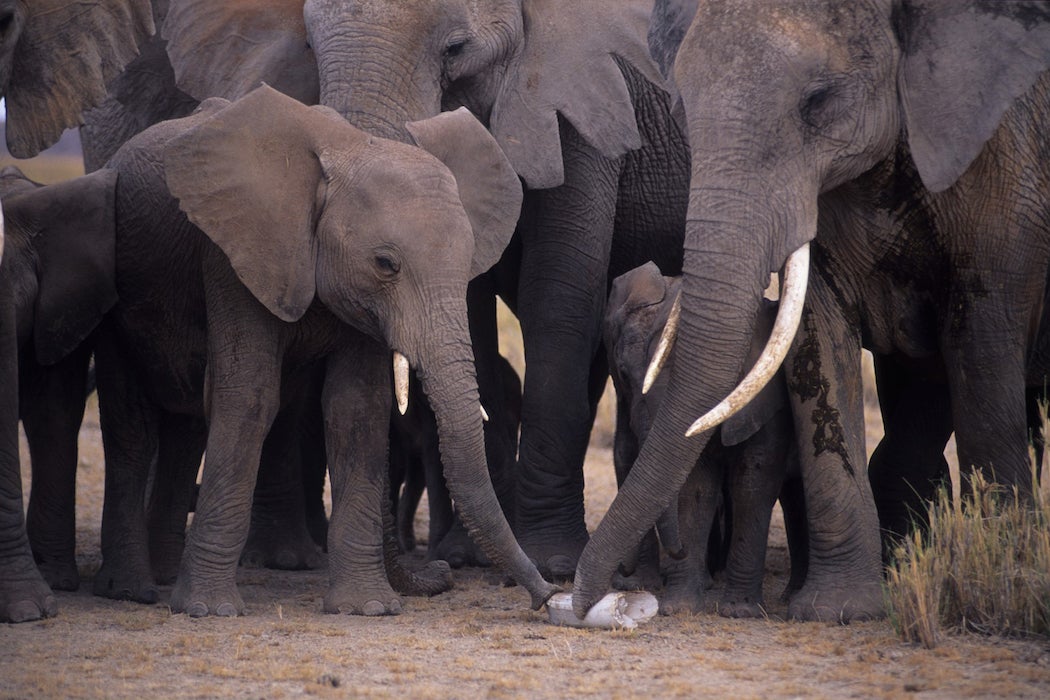Yves Hoareau, a research scientist at the University of Washington, Seattle, removes a set of keys firmly clamped to his belt and unlocks the door to the walk-in refrigerator. Illuminated beneath bright fluorescent lights, the cold, cramped space inside more closely resembles a mail room than a meat locker: cardboard boxes, some of which are adorned with “Kenya Airways Cargo” stickers and “Kenya Customs” packing tape, are stacked on many of the wire shelves. Overflowing within the boxes are small plastic containers, of the sort that are used to collect urine, each of which holds a single precious sample: ivory.
Those slivers of ivory, ranging in size from a child’s pinky finger to a quarter coin, are all that remain of hundreds of elephants that once roamed the savannahs and forests of Africa. All fell victim to the illegal wildlife trade, a multi-billion-dollar industry that rivals drugs, arms, and human trafficking in its scope. Insatiable demand for animals and their parts—including ivory, a popular contraband material for making jewelry or sculptures in China, Vietnam and other Asian countries—is driving the decline of thousands of species around the world, elephants among them. From 2007 to 2014, elephant populations across Africa dropped by 30 percent, predominately due to poaching.
As poaching has picked up, government officials, law enforcement agencies, and conservationists have found themselves engaged in an arms race against criminal wildlife traffickers. Science can help them get an upper hand. The samples here in the fridge, collected from major ivory seizures, will undergo a forensic DNA analysis that allows researchers to pinpoint where the elephants that that ivory belonged to last lived. Regardless of the tricks traffickers pull to try to throw investigators off their tracks, the analysis reliably determines geographic origin of seized tusks.
“Poaching is going on all over Africa, there’s no question, but it’s daunting to think of it that way,” says Samuel K. Wasser, director of the university’s Center for Conservation Biology, who pioneered the game changing method. His lab has used the results of this analysis to identify major poaching hotspots and key criminal organizations, that, if stopped, he believes would likely cause much of the elephant killing to grind to a halt.

Such findings are critical because they inform where limited anti-poaching resources can be most effectively put to use. They also shut down arguments made by certain unscrupulous officials who try to exploit unknowns. Even as poachers recently reduced Tanzania’s elephant population by half, for example, tourism minister Lazaro Nyalandu and the government vehemently claimed that the elephants must have simply wandered away across the country’s border. Shortly after, Wasser and his colleagues published a paper in Science showing that Tanzania was the biggest poaching hotspot in Africa. The elephants, in other words, never left—only their ivory did.
“The big value of Sam’s work is that the evidence he produces is unassailable,” says Timothy Tear, executive director of the Wildlife Conservation Society’s Africa program. “Countries cannot argue with it.”
Tracking the Poaching Hotspots
Wasser’s journey into wildlife forensics began over a decade ago, when he was still a traditional conservation biologist. He spent nearly 20 years working in Tanzania’s Mikumi National Park. His focus there was baboons, but the first elephant crisis—in which Africa’s populations were halved over the span of a decade—was in full swing at the time. Wasser’s field site happened to be one of the most heavily poached on the continent—everywhere he went, he saw elephants’ crumpled remains. The more he witnessed, the more he wished he could stop the killing.
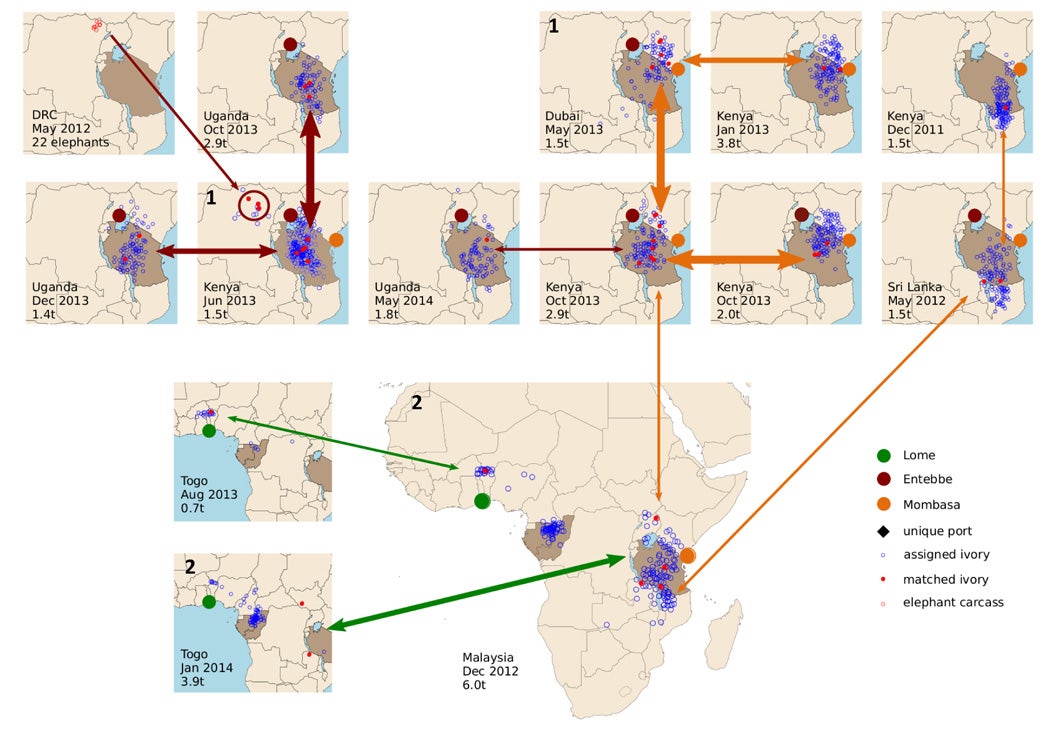
Ruminating on a solution, he came to realize that the methods he had developed to monitor the baboons—specifically, extracting hormones and DNA from their feces to establish population profiles—could also be applied to elephants. In 1997, Wasser and his colleagues began the less-than-glamourous job of scooping up and analyzing elephant feces, and the following year, they figured out how to extract DNA from ivory. By 2004, they finally had enough data to get started on a geographic map of genetic distributions of forest and savannah elephants, which they built up with thousands of feces samples that ultimately provided 1,500 full genotypes from unique individuals across Africa. Wasser identified 16 hyper-variable regions of DNA, called microsatellite loci, which differed between elephant groups. These repeating patterns are key for tracing ivory back to specific locations.
In 2005, Wasser and his team finally received their first shipment of seized ivory samples for analysis. They were able to narrow the origin of the tusks to a minimum precision of 185 miles, and in some cases, they even pinpointed the exact park where the ivory came from. They proved that their method could be an efficient way to battle the global ivory trade.
Ten years later, in 2015, they compiled results from 28 large seizures made between 1996 and 2014 and identified a distinct and surprising pattern. Though ivory may have been intercepted in Sri Lanka, Kenya, Singapore or elsewhere, most seized over the past decade originated from just two hotspots: Tanzania and northern Mozambique (78 percent) and the Central African TRIDOM (22 percent), where Gabon, Cameroon, the Republic of the Congo, and the Central African Republic converge.
While collecting samples for analyses, Wasser also noticed a surprising trend: many of the seizures contained only one tusk from each elephant. To investigate this, Wasser and his colleagues compared the genotypes of all ivory samples in their database and found that the missing tusk would sometimes appear in another seizure made at or shipped from the same port, months later.
As they reported in Science Advances in September, there was, indeed, a high number of matches in seizures made between the peak poaching years of 2011 and 2014, with 26 genetically identical pairs discovered in 11 out of 23 seizures from the time. Based on those matches, he and his colleagues believe that three cartels operating in Kenya, Uganda and Togo most likely control the majority of ivory trafficking out of Africa.
Collectively, Wasser says, these results paint a telling picture of how poaching and trafficking work in Africa. Criminals seem to establish elephant killing sites based on three prerequisites: the area has to have lots of elephants; poachers must be able to operate with little risk of apprehension; and there needs to be an infrastructure—likely enabled by corruption—that allows for ivory to leave the country. Such variables aren’t easy to come by in combination, which is why there are just a few major poaching centers across the continent—and also why disrupting those hotspots would likely have a significant impact. It’s not like criminals could just shift such intricate operations overnight.
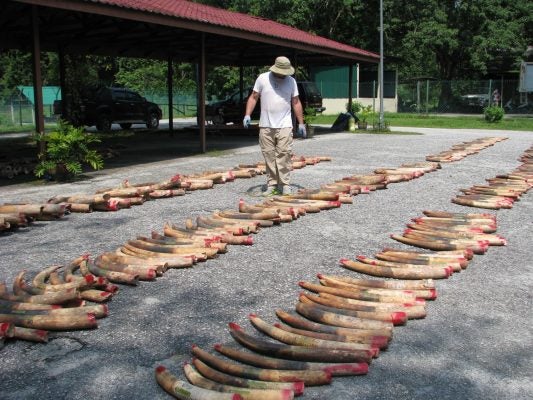
Wasser and his colleagues’ findings have already been a boon for law enforcers. Take the case of Emile N’Bouke, an ivory shopkeeper in Togo commonly known as Le Patron—the Boss. Togo banned domestic ivory trade in 2008, but in 2013, police confiscated over 1,500 pounds of ivory from N’Bouke’s Lomé shop, all of which he claimed came from elephants killed before a 1990 global ban on international ivory trade went into effect, and most of which he said he acquired legally from Chad. When Wasser tested the ivory, however, he found that it originated from a number of sources including Cameroon and Gabon. Another U.S. lab then used radioisotope analysis to date the ivory to elephants killed as recently as 2010. In 2014, N’bouke received a two-year prison sentence and was ordered to pay a fine of over $10,000.
Extracting DNA is a Noisy “Suffocating” Work
“So you wanna know a little about how the process works and everything?” Hoareau asks, his words touched by a slight French accent. “Come with me.”
As one of Wasser’s full-time technicians, Hoareau is well skilled in the technique’s methodology. After our visit to the fridge (the samples are stored there not because they need to be kept cool, he says, but because it’s the most secure place in the lab), he takes me to a small room down the hall.
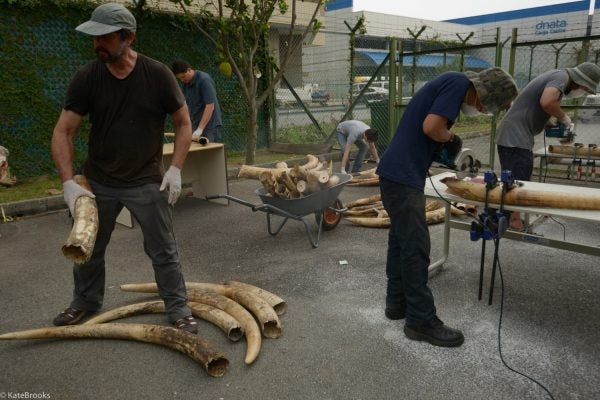
Processing samples like the ones we saw in the double-locked fridge begins with a method similar to one developed by a crime lab in British Columbia for extracting DNA from human teeth, Hoareau explains. He points to a row of small plastic tubes, each of which contains a magnet and two stainless-steel plugs on either end. Ivory samples are put into these tubes and then inserted into a machine called the Freezer/Mill. Liquid nitrogen poured inside causes the sample to become brittle while a magnetic current makes the steel plug act like a piston, smashing the ivory against it. As the machine whips back and forth ten times per second, it pulverizes the sample until it becomes as smooth as baby powder.
“It sounds like a jackhammer when it’s going—it’s super loud,” Hoareau says. “But we have to keep the door to this room open because of the liquid nitrogen. It evaporates, and if you don’t allow it to mix with the air, it’ll cause you to suffocate when you come back in. But that means everyone down the hall gets to enjoy the noise.”
Powder in hand, Hoareau and his colleagues next use a chemical reagent to separate minerals like calcium from DNA molecules. They extract the DNA and run dozens of high-throughput polymerase chain reactions, creating millions of genetic copies—enough to be sequenced by a very expensive, very specialized machine, the 3730 DNA Analyzer. After a day or two of processing, the DNA Analyzer spits out thousands of finished readings. The researchers compare the results to their reference map of alleles from the 16 different microsatellite loci that Wasser showed to reliably distinguish elephant populations. Once that’s done, boom, they’ve got their answer. It sounds like a lot, but Hoareau and the other two full-time techs can process the 200 samples collected from each seizure in about three weeks.
“What I find to be especially interesting about this lab is that there is actionable conservation going on,” Hoareau says. “Oftentimes in science, you publish a paper showing some results, but it’s hard to have the politics necessary to actually do something about it. Here, we have a working relationship with governments and international law enforcement authorities, which helps assure what we do has a direct impact on the preservation of elephants.”
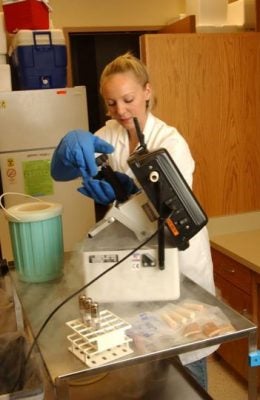
The lab is no doubt having a positive effect. But as is so often the case in combatting the illegal wildlife trade, it could be much greater, should officials actually do their part by submitting their seizure samples for origin analysis. Most countries don’t get around to doing this for a year or more after a seizure, Wasser says, which reduces the law enforcement value of the information that results. Some do not comply at all—including a number of nations that play major roles in the illegal ivory trade. “We try to encourage them to promptly send in their samples, but applying too much pressure can have the opposite effect,” Wasser says. “It’s just a dance, but it’s endless and it wears you down.”
Vietnam, for example, has seized over 30 tons of ivory since 2010, but it wasn’t until 2016 that they allowed Wasser to collect samples from just one of those seizures. The ivory in question, which came from a 2.2-ton seizure made in 2010, originated from elephants that last lived in Tanzania, Wasser found. “Our hope is that this effort will open doors to sample the 45 tons of ivory that Vietnam has seized since 2010, and especially the large number of seizures they have made recently,” he says.
Get Our Newsletter
Still, it’s frustrating, he continues, to know that data that could put a significant dent in ivory poaching and trafficking are available in ivory storehouses around the world, yet for now remain distressingly out of reach due to lack of collaboration. If everyone simply turned over samples from recent seizures he and his colleagues could produce results that would help officials and law enforcement identify where they need to go to shut down the ivory trade in its current form. “That’s the hardest part for me: seeing how powerful a tool we have, and yet countries are still reluctant to let us use it,” he says. “If people would just work together, it would make all the difference in the world.”
These issues are not unique to ivory, and so the battle to shut down the illegal trade continues. The method is already being used successfully to track tiger poaching, and a graduate student and a post-doctoral researcher working in Wasser’s lab recently began building similar genetic maps for pangolins.
“I’m certainly not going to give up, ever,” Wasser says. “And lots of my colleagues are not going to give up ever, either.”
